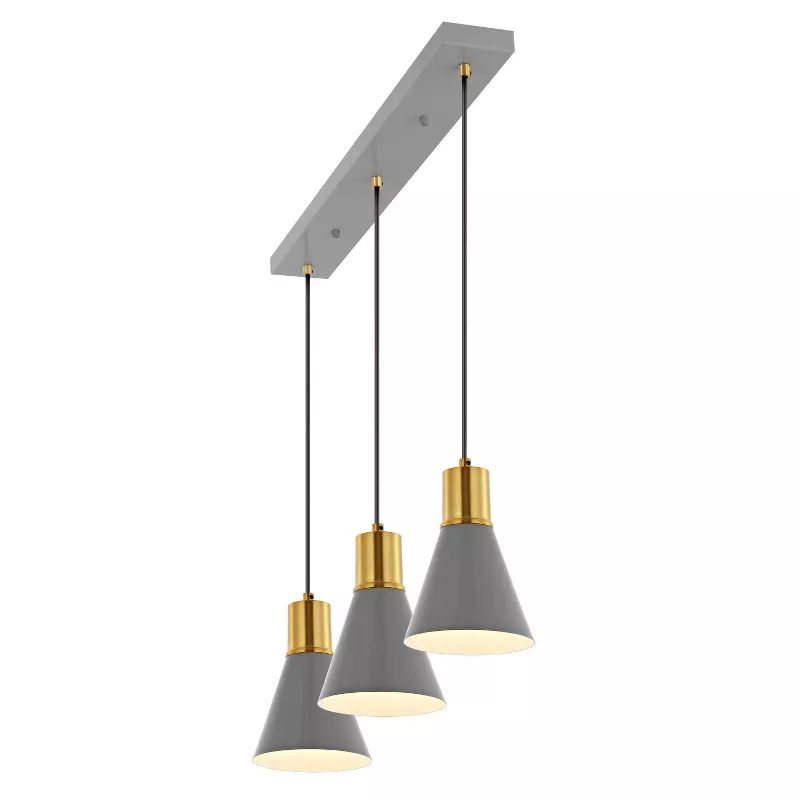20 Dining Room Lighting Ideas That Will Elevate Your Entertaining Game
Designers say a layered lighting scheme is a must for atmospheric dining, and these are the stylish ideas they recommend

Lilith Hudson
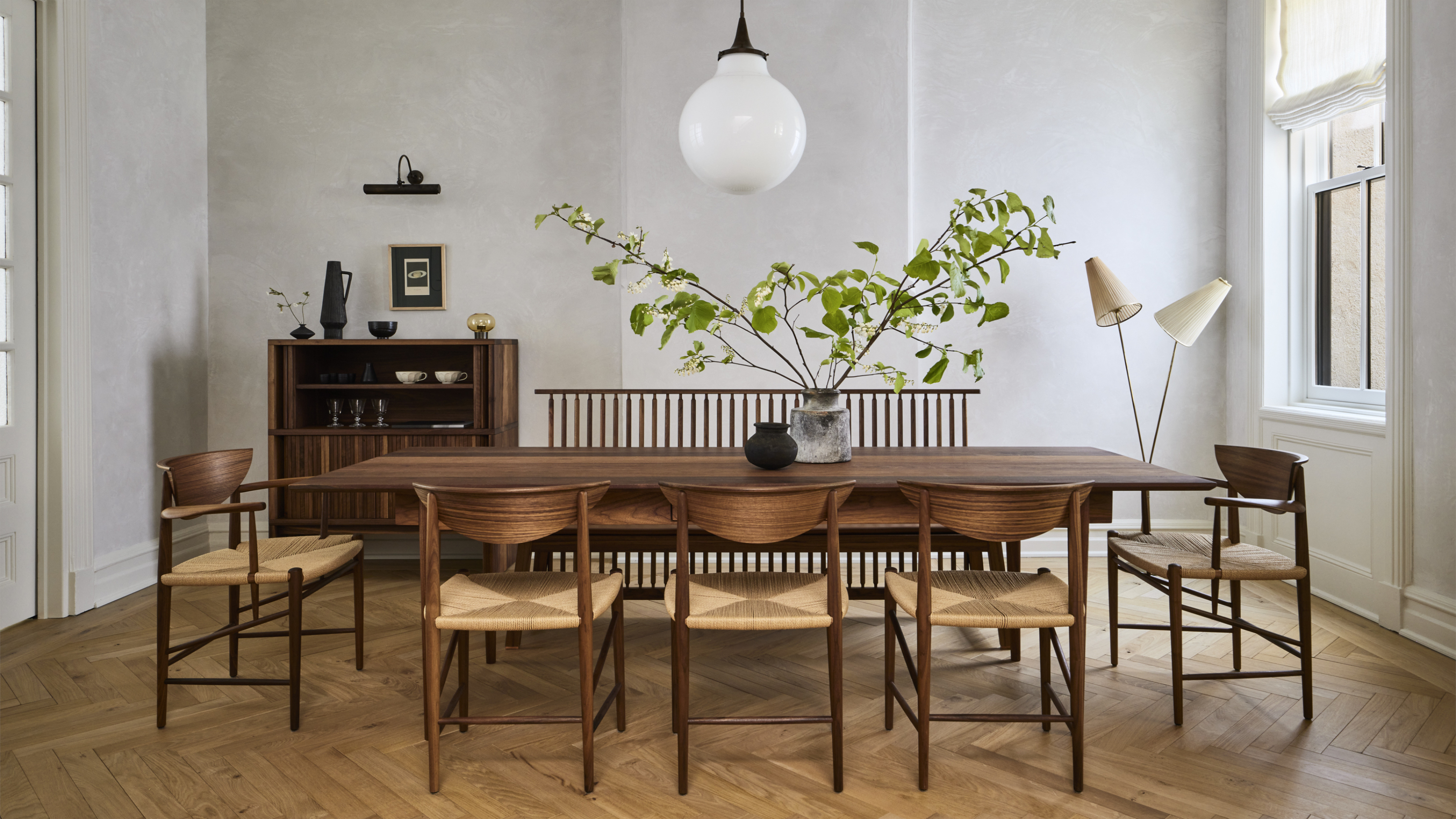
- 1. Choose a statement fixture as a focal point
- 2. Add portable table lamps
- 3. Use dimmable sconces along the wall
- 4. Try industrial pendants to add some edge
- 5. Spotlight the dining table
- 6. Add visual interest by working with shadows
- 7. Create clean lines for a simple but striking effect
- 8. Group pendant lights in threes
- 9. Let your table influence your lighting choices
- 10. Make a statement with a quirky chandelier
- 11. Add texture with natural materials
- 12. Use floor lamps to soften the space
- 13. Play with scale with an oversized pendant
- 14. Use dining room lighting to blend styles
- 15. Keep it minimal with exposed bulbs
- 16. Mix and match for an eclectic rustic style
- 17. Reduce clutter with spotlights
- 18. Double space and light with mirrors
- 19. Switch pendants for statement wall lights
- 20. Go classic with a chic paper shade
- FAQs
From formal dinner parties to everyday evening meals, we ask a lot of our dining rooms. But if you want a versatile dining space that can step up to any occasion, you'll need to nail your lighting ideas.
It's become increasingly common for our dining rooms to be multifunctional spaces, be it a makeshift WFH office or a traditional space to host the extended family for special occasions. That means your lighting has to be multifunctional, too. You need strong overheads that you can work by as well as more atmospheric lighting that sets the mood. Task, ambient, and accent lighting all play an important role.
And of course, as well as thinking practically about incorporating lighting into your dining room ideas, aesthetic appeal should be a consideration, too. The style and material of your lighting choices help to add texture, color, and interest to the wider room, helping to tie into a wider interior design style and coordinate with the rest of the space.
If you're looking to redesign your lighting scheme or add some additional layers into the mix, we asked experts for their best dining room lighting ideas to get you started. From statement chandeliers to dimmable wall sconces, here are twenty styles they're using for a beautifully lit dining space.
1. Choose a statement fixture as a focal point

One of the best ways to make your dining room lighting stand out is to choose a statement fixture to hang over the dining table. This works especially well if you have a round dining table where one large pendant, shade, or armed fixture can work as a focal point. (For larger dining table ideas, you may want to use cluster lights or multiple pendants, instead.)
"If the room’s sole purpose is a dining room, we are big believers in creating a focal point of drama by choosing a chandelier or low-hanging cluster of pendants that will float prettily as a centerpiece in the room and atop the dining table as a practical light source for wining and dining," says Helen Pett, design ambassador for Arteriors London. Consider the material used, too. In the space above, the brass finish adds an alluring luster to the room, while a sparkly glass chandelier would add a luxe, regal feel while helping to reflect more light around the room.
2. Add portable table lamps

One of the lighting trends we're loving right now takes inspiration from restaurants. There's something that feels so elegant about a dimly lit room with a small table lamp centered on a bistro-style table. Like candlelight, it makes the room feel intimate and personal, and there's no reason you can't adopt the same ideas in your dining room.
The Livingetc newsletters are your inside source for what’s shaping interiors now - and what’s next. Discover trend forecasts, smart style ideas, and curated shopping inspiration that brings design to life. Subscribe today and stay ahead of the curve.
For ultimate flexibility, a portable table lamp is the way to go. These rechargeable lamps can be moved from your dining table to a buffet table, right through to your living room when you've finished eating. "Perfect for injecting a designer flourish, team them with a decorative fabric shade to complement your tablescape," suggests Jo Plant, Head of Design at lighting brand, Pooky.
3. Use dimmable sconces along the wall

Small atmospheric lights such as table lamps are known as accent lighting, and wall lights are another great way to layer your lighting scheme and set a cozier tone to dine by. Consider flanking a large window with dimmable sconces so you can control how the space feels as the natural light fades, or use them to line an empty wall.
“Wall sconces are a great addition to dining rooms — they are ultra versatile for layering light and are essential for enriching spaces with character," notes Mara Rypacek Miller, Founder of homeware brand Industville, which specializes in lighting. "From lowering light levels to create intimacy or brightening lights for important tasks, dimmable sconces allow you the ability to delicately control the ambient mood, empowering you to do more with your spaces.”
4. Try industrial pendants to add some edge

Few of us have traditional formal dining rooms these days. Instead, an open-concept kitchen diner is the norm. To keep the style relaxed and draw motifs that run from the kitchen to the adjoining dining space, consider industrial-style pendants in your dining room lighting ideas. Not only do they look chic and contemporary as double or triple pendant lighting, but they're also super practical, helping to spotlight the table while you eat.
"Adding an industrial pendant or two over a dining table is an excellent way to infuse a modern touch to more classic dining room schemes or breakfast nooks," Maya explains. "Handcrafted pewter or brass dome pendants work particularly well for this and pair well with rich, classic colors such as dark greens, terracottas, and maroons to add to the timeless charm." And, as banquette-style seating becomes increasingly popular, they help create a retro diner-inspired look, too.
5. Spotlight the dining table

Whether your dining space is in a room of its own or part of an open-plan kitchen diner idea, the main focus is always going to be the dining table. Hanging lighting directly above is not only going to help enhance that point of focus it's also the most practical place to start with your lighting scheme.
"Decorative pendants are very popular for above dining tables as people want to make a statement and a feature," says Piero de Marchis, Director of Detail Lighting. Pendants look chic and can provide that all-important task and ambient lighting we mentioned earlier. They could even become accent lighting too — surrounding the dining table in a pool of light which can be very effective for dinner parties when the rest of the room is only dimly lit.
6. Add visual interest by working with shadows
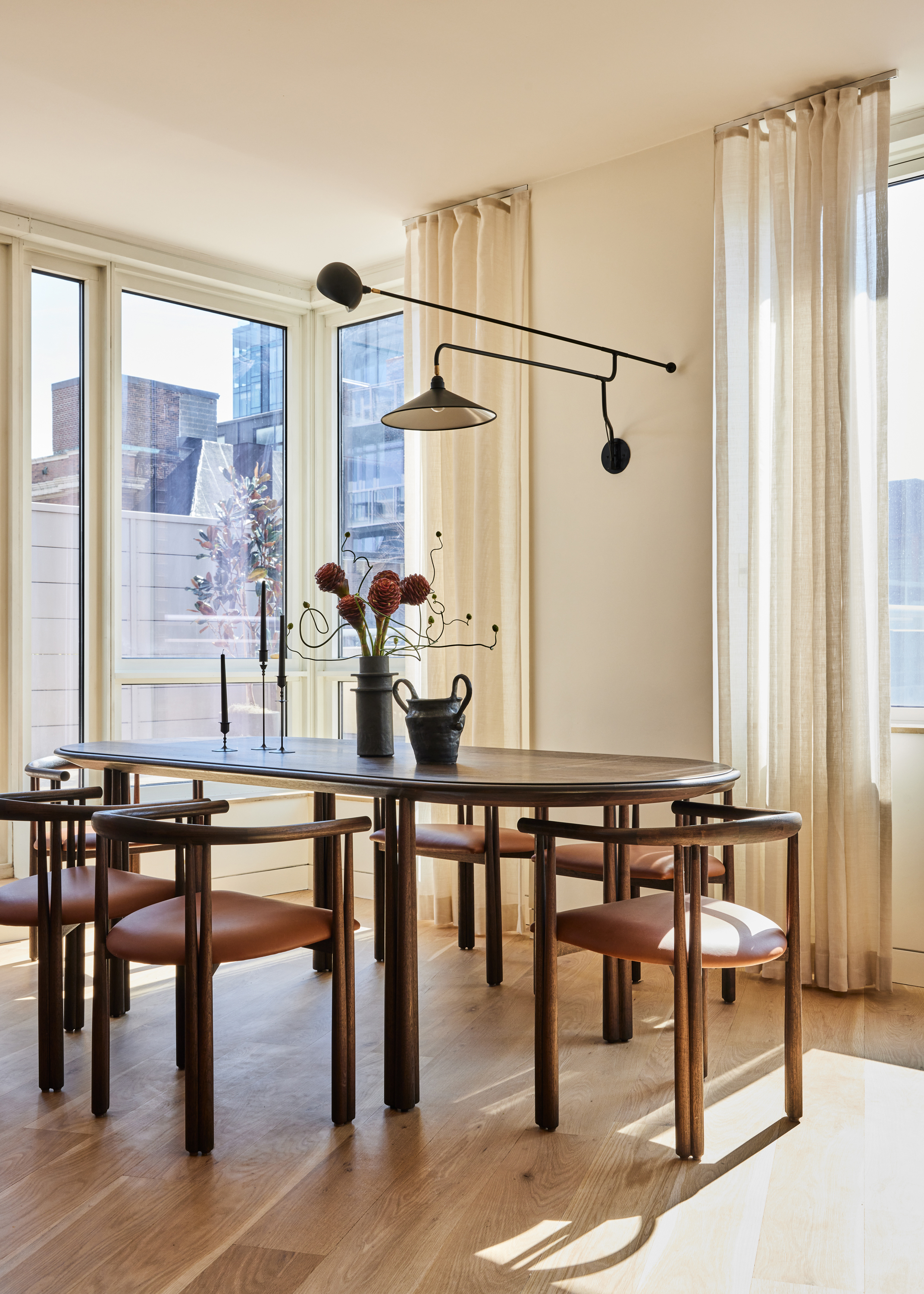
Light and dark go hand in hand, so think laterally and be sure to factor in the effect of shadows on your dining room lighting scheme. "Lighting fixtures can offer a playful way to explore effects that add visual interest and depth to a space," explains Helen. Wall lights, for example, can cast a beautiful shadow across your wall if they're used as the main lighting source with no overhead.
Similarly, fixtures with long arms or structural lines will have a playful effect when they interact with other light sources. The same goes for shades, too. "Shadows cast by the cutouts, folds, or perforations in intricately designed shades or bases will cast eye-catching patterns, making a room feel more dynamic," adds Helen.
7. Create clean lines for a simple but striking effect

To make a statement, your dining room lighting needn't always be oversized and super bold. If you prefer a more minimal look but still want your lighting to stand out, a design with clear, sleek lines always works, especially in small dining rooms.
Pick a color that's going to contrast the walls and ceiling too so the structure really pops against the background. We love how the contemporary chandelier pictured here floats above the simple dining table, adding depth and focus to the neutral color palette and natural textures. Also note how the black finish mirrors the chairs and picture frame, helping to balance the room. Look for striking silhouettes in a finish that carries through the rest of the room for a similarly cohesive look.
8. Group pendant lights in threes

While it may be tempting to keep things symmetrical and opt for an even number of lights above your dining table, good things do come in threes, and going for odd numbers creates far more interest. Hanging your lights at varying heights will also mean they can be multifunctional. A low-hanging light is ideal to work by while the higher lights contribute to the overall ambient lighting.
9. Let your table influence your lighting choices

Since most dining room lighting ideas are based around the dining table, be sure to consider the shape and style when choosing your lighting. "For those with round or square dining tables, a centrally positioned pendant or pared-back directional chandelier with one or multiple light sources would work really well, as do a cluster of pendants hanging at different heights," says Rohan Blacker, founder of Pooky. The latter of these is a great way to get the correct light height over a dining table while also providing optimal lighting for dinner time.
For longer, rectangular tables, these require lights that spread across the length of the table. "We recommend opting for either a linear chandelier with multiple light sources as part of its design or a trio of pendants styled side by side which will have the same effect," adds Rohan. "For a playful touch, use different colors, finishes, or even different pendants but complement shapes and styles. This will draw the eye and add a dash of quirky personality to the room."
10. Make a statement with a quirky chandelier
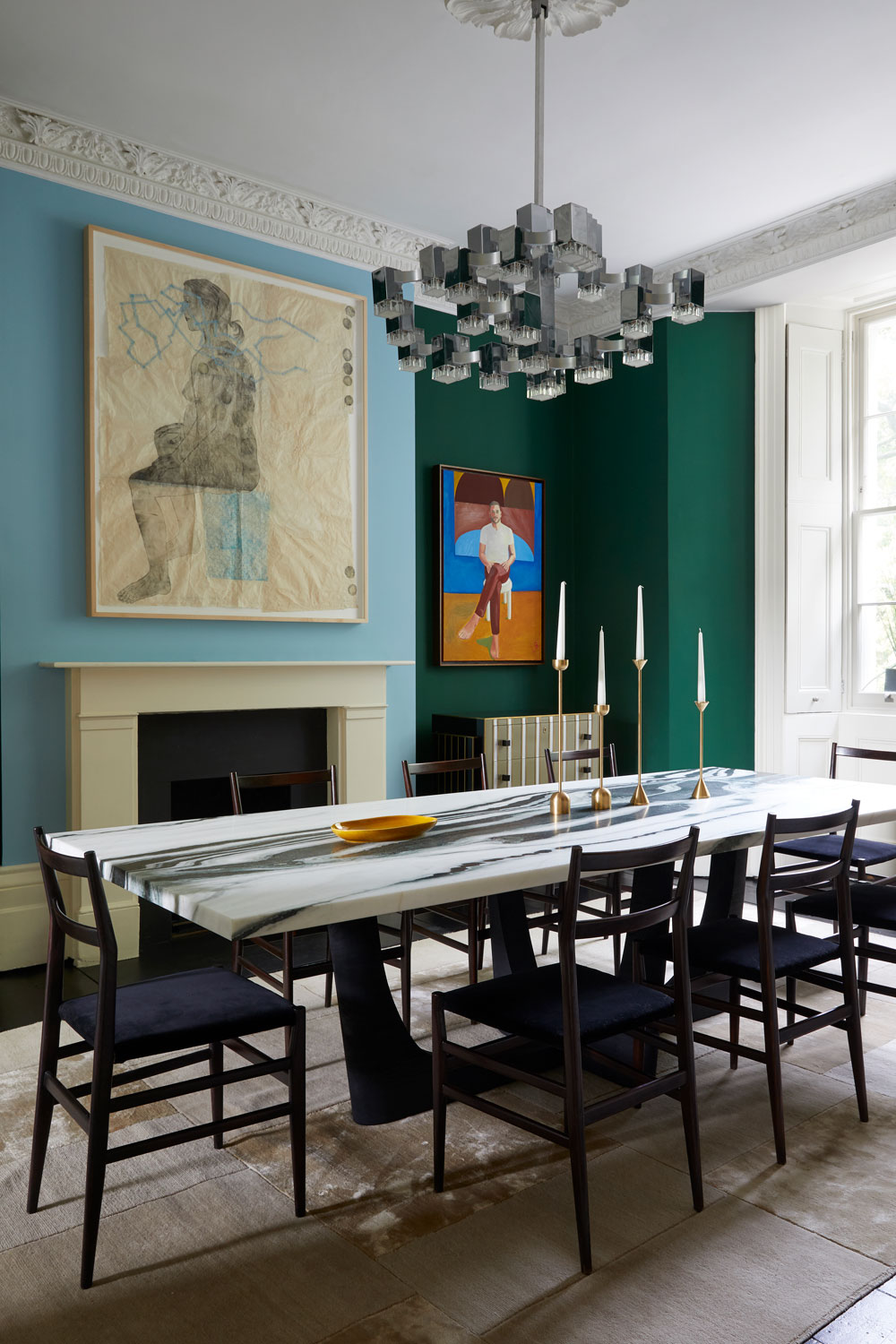
We always say when it comes to designing a dining room you can be experimental with the decor. This is because they're spaces that are typically used for special occasions, so bring in quirky, unexpected pieces that might overwhelm a more lived-in room. Not only do they make great talking points, but they also make your dining room lighting feel more elevated and special compared to the rest of the home.
To bring this idea to life, consider a dramatic low-hanging crystal chandelier or a statement art deco design. "You can opt for antique or antique-style, tendrilling models with toleware florals and antiqued brass finishes," says interior designer Matthew Williamson. Since it hangs above the table you don't need to worry about being able to fit underneath it but we'd recommend hanging it no lower than three feet above the tabletop.
11. Add texture with natural materials

Being a practical space, it can be tricky to add textures to a dining room. If you think your eatery needs some added warmth, fixtures made of natural materials are a great way to make a lighting scheme feel cozy.
Rattan pendants are a classic and work with so many styles from minimalist Scandi spaces to modern rustic rooms. Plus, if you are just switching a shade it can be an easy switch with no electrician needed. Just be sure to choose a shade that not only looks lovely but is going to disperse the light nicely too. "Handcrafted fixtures made from unique, luxurious materials like coconut wood or brass are a perfect way to add a talking point to a room," says Helen at Arteriors. "It will also draw gazes upwards lending the room a feeling of grandeur."
12. Use floor lamps to soften the space

Pendants do tend to be the focus when it comes to dining room lighting ideas, but the humble floor lamp can be an important addition too. The best floor lamps cast a glow around the edges of the room where pendant lights might not reach and ensure that not all your lighting sources come from directly above so you don't get any harsh shadows. The key to a good lighting scheme in any room is layering, so be sure to have different sources at different levels.
"The key is to create little pockets of light that work together to create a level of lighting that feels at once restful and atmospheric," says Matthew. "Use lamps on either side of the dining table and pair these light sources with a chandelier or pendant light with dimmable bulbs for added decadence." Floor lamps can be used as task or accent lighting, too, if you want to highlight a piece of furniture like an occasion chair or a bar cart.
13. Play with scale with an oversized pendant

Going oversized with your lighting is a really easy way to make a statement and add an instant focal point to your dining room. An effective approach is to play with scale but also to create balance; you want to avoid a huge light floating over a room of tiny furniture, so even out a large light by choosing a selection of other pieces too. Simplicity is also on your side, here. We love how a giant oversized pendant can completely transform a dining room.
14. Use dining room lighting to blend styles

Something that gives a dining room real personality and intrigue is the mixing of styles — and it doesn't have to be anything too bold, either. If you like Mid-century modern, for example, you can still go with that on the whole, but bring in just a touch of something from a different era or style to add an unexpected twist.
Of course, lighting is an obvious way to blend styles — a vintage chandelier in a minimalist space, a retro Sputnik pendant in a more traditional dining room, or an industrial wall light blended into a rustic farmhouse style, for example. Lighting is usually easy and relatively affordable to switch out, too, so you can get creative and experiment with different styles without the commitment.
15. Keep it minimal with exposed bulbs

Exposed bulbs are a classic look that's never going to date, so they make a timeless choice for your dining room lighting ideas. Simple glass drop pendants work perfectly, flooding a dining table but also omitting enough of a glow to provide light for the rest of the room. Just be sure to choose warm lights rather than cool ones to make your overhead lighting feel less harsh. Also, hang them low and in groups so they create just enough of a statement that they don't totally blend into the background.
16. Mix and match for an eclectic rustic style
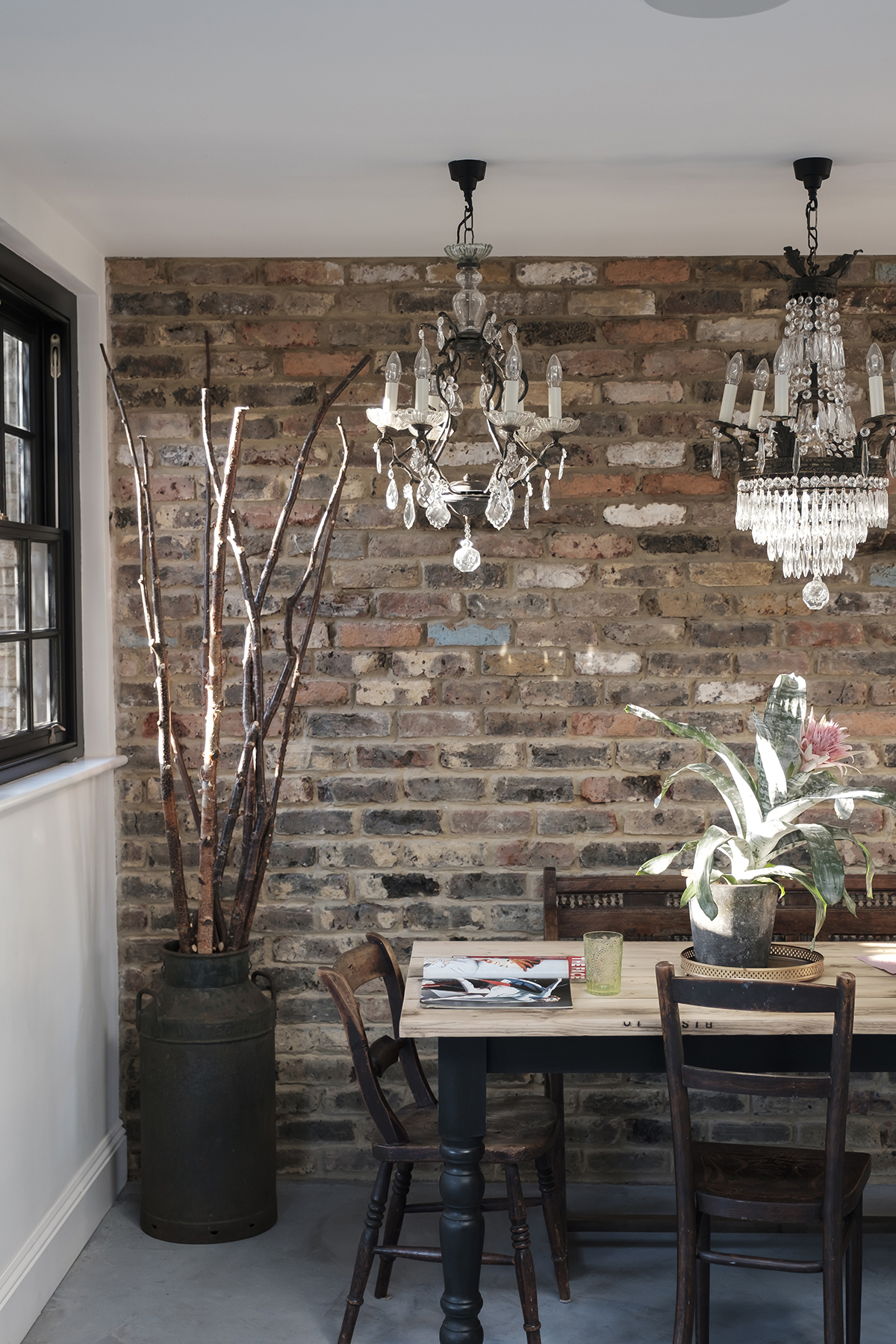
Symmetrical, "matchy-matchy" lighting ideas can make a dining room look too formal and lack character. If you want a space that's truly unique and personal, consider mixing eclectic lighting choices for a nuanced look. Think different-sized pendants hung at varying heights, wall lights and lamps with pleated shades, and some simple recessed spotlights overhead. Mix and match the designs for a look that's equally as striking as a single light and ideal for adding a slightly eclectic rustic touch to a dining room.
Don't forget to factor in dimmer switches so you can control the amount of light, too. Chandeliers can have a lot of bulbs and while that's perfect when you need a strong overhead light you also want the option to dim them to candlelight-vibe levels for dinner parties.
17. Reduce clutter with spotlights

Spotlights might not be the most glamorous of dining room lighting ideas. In fact, in terms of style, they barely add anything — but that's the point. Spotlights are ideal for adding bright lighting that can mimic natural sunlight without taking up any space or adding any visual bulk to a room. This makes them perfect for smaller eateries and minimalist dining rooms, but also a good option for ones that lack natural light and are used for more than just evening meals.
18. Double space and light with mirrors

It's design 101 that mirrors expand space but they can also be used to bounce more light around the room. So, if your dining room lacks natural light or just you want to make it even lighter, position mirrors near your light sources to create an extra glow.
You could opt for a large mirror opposite your main light source for maximum effect or, for a more subtle and romantic look, position a floor mirror behind a floor lamp or a wall-mounted design in between two sconces. Mirrors also have a lovely effect when the lights are dimmed and the candles are lit as they can create the illusion of even more flickering lights.
19. Switch pendants for statement wall lights

A great lighting design tip is to use wall lights on a large scale. For example, rather than relying on pendant lights, you can choose large wall lights on an adjustable arm that you can then position over your table, as you would a pendant.
This helps to make your dining room lighting more multi-functional, too. "If you plan to use the dining space as a makeshift study, the room’s lighting will need to be adapted with additional light sources to accommodate its multifunction," explains Helen. Complementary wall lights on three of the four walls, for example, will allow for a sufficient spill of light while still adding a decorative element, or you could install rows of downlights across the ceiling to ensure the light is evenly spread across the space."
20. Go classic with a chic paper shade

Never underestimate the humble paper shade. Rice paper shades make for a timeless dining room lighting choice, and their simple design means they'll make an elegant statement without going over-the-top.
When picking the perfect shade, go slightly oversized and be sure to pick a good quality design. They're definitely an affordable option but you want the shade to have some weight and texture to it so it disperses the light nicely around the room and gives off a soft warm glow.
FAQs
What type of lighting is best for a dining room?
As with all rooms, the best way to light a dining room is to layer your lighting and ensure you have the right lighting for all the different uses of the space. First, you want to make sure you have your three types of lighting covered — task, ambient, and accent — but also consider when the space is used, too. Dining rooms are often used at night so you can be more dramatic with your choices than you might be in other rooms to create that all-important ambiance.
Pendant lights and chandeliers are a popular option for dining rooms as they can be hung low over dining tables. Be sure to add lighting at the edges of the room, too, in the form of table lamps and floor lamps.
"Always install a dimmer switch for lights in a dining space and, if possible, make sure you have the decorative lights on a different circuit to the functional ones if you do have the two sets," adds Rohan at Pooky. "This gives you options for creating a certain mood depending on the occasion; from bright, practical lighting for daily family meals to subtle and romantic mood lighting for a more formal, entertaining affair."
How big should a light be over a dining room table?
The easiest way to decide on the size of a light over a dining room table is to use your table to dictate the size. A general rule of thumb is that a chandelier should be approximately one-half to two-thirds the width of the table you will be hanging it over. It should also hang no lower than 36 inches from the table and no closer than 48 inches from any walls or surrounding furniture. "To ensure it’s a comfortable setting, don’t forget to consider the height of the light you’re using and choose a position that’s not at eye level when seated," adds Peter Legg, Lead Designer at där lighting.

Formerly the Digital Editor of Livingetc, Hebe is currently the Head of Interiors at sister site Homes & Gardens; she has a background in lifestyle and interior journalism and a passion for renovating small spaces. You'll usually find her attempting DIY, whether it's spray painting her whole kitchen, don't try that at home, or ever-changing the wallpaper in her entryway. She loves being able to help others make decisions when decorating their own homes. A couple of years ago she moved from renting to owning her first teeny tiny Edwardian flat in London with her whippet Willow (who yes she chose to match her interiors...) and is already on the lookout for her next project.
- Lilith HudsonFormer News & Trends Editor


